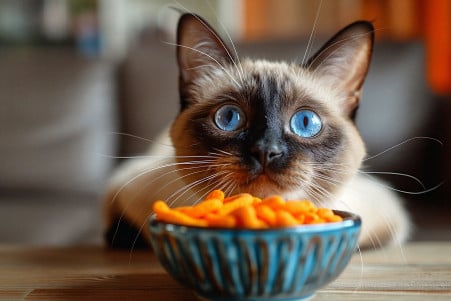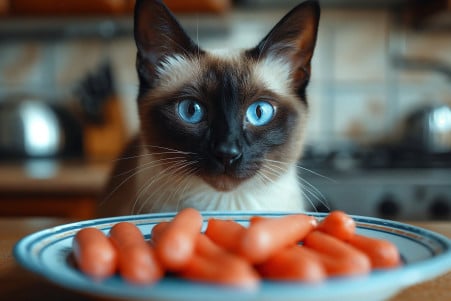Can Cats Eat Marshmallows? What Feline Dietary Needs Mean
7 February 2024 • Updated 7 February 2024

While marshmallows are a tasty snack for people, can the same be said for cats? Cats cannot eat marshmallows. Not only do they lack nutritional value, but they can also pose a choking hazard. The sugar in marshmallows can contribute to obesity in cats, and the sodium in marshmallows is too high for a cat’s dietary needs.
In this exploration, we’ll use veterinary perspectives and nutritional research to explain why cats have dietary needs. We’ll look at the impact of sugar and empty calories on cats, learn about healthy treat options, and find out more about what cats need from their diet. By the end of this exploration, you’ll have a complete understanding of why marshmallows and other human treats are bad for your cat.
Can cats eat marshmallows?
The Bitter Truth: How Sugar Affects Cats
While an occasional sweet treat may not seem like a big deal, the same can’t be said for cats. As Forbes points out, research has shown that cats, who are obligate carnivores, are not hardwired to seek out sweet treats like marshmallows, mainly because they can’t taste sugar.
Cats’ inability to taste sugar means that, unlike people, their dietary history doesn’t prepare them to process large amounts of sugar since their ancestors’ diet was high in protein and low in carbohydrates.
As a result, cats’ metabolisms have evolved to handle their carnivorous diet, according to a study published in PMC. This means that cats aren’t well-equipped to digest and metabolize high levels of carbohydrates and sugars, which can lead to problems like obesity, diabetes, and dental issues.
Catster explains that obesity, type II diabetes, and oral health problems are all examples of the health issues that cats can develop if they eat too much sugar. Meanwhile, PetMD points out that high blood sugar is a sign of diabetes mellitus, a disease that can be life-threatening for cats, which further underscores the potential dangers.
Not only does adding sugar to a cat’s diet put them at immediate risk, but it also sets them up for long-term health problems. Understanding this is important for protecting cats’ overall health and well-being and ensuring that their nutritional needs are met.
Understanding What Cats Need in Their Diet
Cats are obligate carnivores, and their evolution has shaped their nutritional requirements. They need a diet that includes animal-based proteins that provide the essential amino acids they need to survive.
According to a study from VCA Animal Hospitals, some of the amino acids that cats need, like arginine and taurine, are only found in animal tissues. Fats, especially omega-3 and omega-6 fatty acids, are also important for maintaining healthy skin and fur, as well as helping with wound healing and reducing inflammation.
On the other hand, cats don’t need carbohydrates, like the kind found in marshmallows. According to PetMD, cats should get less than 10% of their daily calories from carbs, while dogs can tolerate a higher amount of carbs in their diets. In addition, cats have specific vitamin needs that are different from dogs, so their diets need to be formulated to meet their unique needs.
This is why it’s so important to look for commercial cat foods that meet the standards set by the Association of American Feed Control Officials (AAFCO). These foods are formulated to be complete and balanced, meaning they contain all the nutrients cats need to thrive. Knowing these nutritional requirements can help cat owners make better choices and avoid giving their pets human foods like marshmallows that don’t meet their natural needs.
Dangers of Cats Eating Human Food
Many human foods can cause health problems for cats due to their digestive systems. PetMD notes that chocolate, caffeine, and dairy are especially problematic, leading to issues like vomiting and diarrhea. Meanwhile, eating raw meats and eggs, or foods that contain garlic and onions, can cause even more serious problems, including Salmonella or E. coli infections and anemia.
In addition to the immediate risks of feeding cats human food, there are also potential long-term risks of nutritional deficiencies. The Spruce Pets explains that feeding cats human food can lead to a lack of proper nutrition and even malnutrition, as it can lead to a lack of interest in eating cat food, which is where they get the bulk of their nutrition.
Over time, this can lead to health problems like obesity and diabetes, which can shorten a cat’s life and reduce their quality of life.
While there are some human foods that cats can eat in moderation, like cooked lean meats and certain vegetables, it’s important to make sure that these foods don’t contain any toxic ingredients and that they don’t make up a significant portion of a cat’s diet.
This means that it’s important to be careful when it comes to feeding cats human food, and to prioritize their health and nutritional needs over the desire to share food with them.
How to Choose the Best Treats for Your Cat
When shopping for cat treats, it’s important to make sure you’re choosing treats that are in line with your cat’s dietary needs. Look for low-calorie treats that offer functional benefits, like dental care.
The Spruce Pets recommends Wellness Kittles and Feline Greenies Dental Treats, which are both made with natural ingredients, low in calories, and fortified with vitamins and minerals. American Trek also makes soft and chewy treats that are low in calories—important since treats should make up no more than 10% of a cat’s daily caloric intake, according to VCA Animal Hospitals.
Homemade treats made with safe ingredients can also be a healthy option. Dr. Kerri Blackburn, a veterinarian, says that homemade treats made with cooked meats and low sugar can be nutritionally adequate for cats, but she warns against feeding cats raw or undercooked treats, which can contain harmful bacteria.
To prevent your cat from gaining weight, it’s important to make sure you’re feeding them the right amount of treats and feeding them at the right frequency. Feeding treats no more than a few times a week can help ensure they don’t lose their appeal and that they don’t become a larger, less healthy part of your pet’s diet.
By choosing the right treats and making sure your cat doesn’t eat too many of them, you can make sure you’re keeping your cat’s taste buds happy while also supporting their health and well-being.
What Are Cat Food Sensitivities: Allergies vs. Intolerances
Cats can have food allergies and intolerances, which are two different reactions that can have similar symptoms. However, the causes of these reactions are different. Food allergies in cats are an immune-mediated response to certain proteins and are often associated with skin and gastrointestinal problems.
A study in PubMed found that the most common allergens in cats were beef, dairy, and fish. On the other hand, food intolerances are not immune-mediated and are often dose-dependent, with symptoms showing up hours or days after the food is eaten. This was found in a study in the Journal of Small Animal Practice.
Determining the specific food that is causing the problem often requires an elimination diet, where potential allergens are removed and then reintroduced in a controlled way to see if they cause a reaction.
A study in MDPI found that a saliva-based test could be used as an alternative to an elimination diet to determine food sensitivities. If a food sensitivity is found, the cat’s diet can be managed by switching to a hypoallergenic or therapeutic diet that is formulated to avoid the allergens that have been identified.
For cat owners who are dealing with their cat’s food sensitivities, the most important thing is to be vigilant and flexible. Removing or replacing foods that cause a reaction can make a big difference in a cat’s health and well-being. Knowing how to recognize and manage food allergies and intolerances is one way to make sure that your pet is as happy and healthy as possible.
Conclusion: Cats and Marshmallows
In conclusion, the idea of cats eating marshmallows is a prime example of a failure to provide proper dietary care for felines. Marshmallows are nutritionally void, a choking hazard, and the sugar they contain can lead to obesity and other health problems. We have emphasized the importance of a diet that is in line with a cat’s natural carnivorous diet, which means low carbs and no added sugars.
Being a responsible pet owner means making sure you know and understand your cat’s unique nutritional needs. It also means consulting with veterinarians, especially when it comes to making any changes to your cat’s diet or addressing health issues. As pet parents, it is our responsibility to make sure we are feeding our cats in a way that supports their health and well-being.
Let’s rise to the occasion that comes with being a pet owner. By avoiding marshmallows and other inappropriate human foods in our cats’ diets, we can make sure we are supporting their health and honoring their natural history. After all, the best treat you can give your cat is a long, healthy, and happy life.


